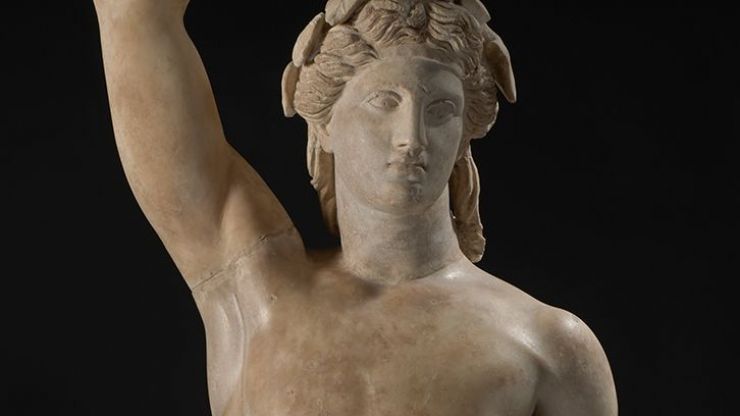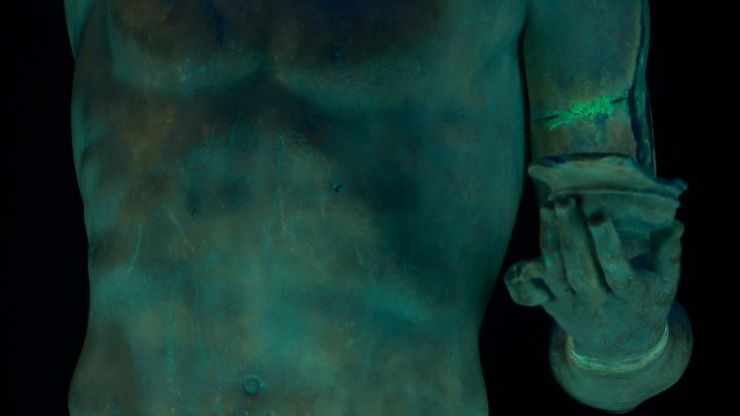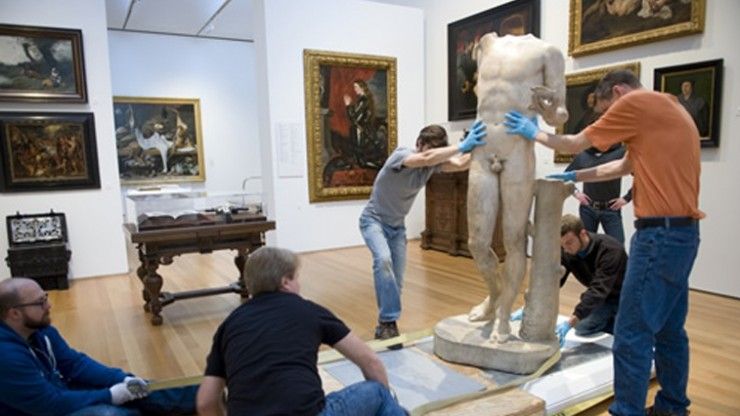Those of you who love to stroll through the Flemish Kunstkamer (art room) in West Building will undoubtedly have noticed that the marble statue of Bacchus was nowhere to be seen on your recent visit. Where did Bacchus go? Not too far, actually. Bacchus took a stroll of his own down to the conservation lab for the makeover of the century. Let me tell you why.


Bacchus was accessioned into the Museum collection in 1958—when he had a head on top of his finely muscled body. However, it was soon learned that this sculpture of Bacchus was a composite of ancient parts assembled together with more recent additions. In such cases composite sculptures are sometimes dismantled to remove the ancient components from the later additions and display them separately (while often discarding the later additions).
Thus, in the ’80s, Bacchus’s head was removed from the rest of sculpture and displayed by itself in the galleries. The Head of Bacchus is currently on view in West Building. This head is a genuine Roman antiquity, and it was once part of an ancient statue of Bacchus, now lost.
As for the body, it was relegated to storage because it was not as elegant as the classical sculptures already in the collection. The superbly chiseled torso is also a genuine Roman antiquity of a rare type, but the legs, left arm, base, and that weird-looking tree trunk are actually baroque additions. (Plus, it does not even represent Bacchus!) NCMA curators and conservators have known this since the early ’60s. Unfortunately, when the head was removed in the ’80s, the Museum did not have the means or the technology to take the sculpture apart any further. And so it was in storage that “Bacchus” languished until he was rescued by Dutch and Flemish art curator Dennis Weller in 2002 and displayed in the Kunstkamer.
(Fast forward to 2013)
After having completed and published the research on the Egyptian collection (2012), I decided the classical collection was to be the object of scholarly research, a new project that started in 2013. Rather than attempting this on my own (I am an Egyptologist, after all), I am bringing in classical art experts in various fields to study our objects. The first consultant was Mark Abbe (assistant professor at the University of Georgia, Athens), whose expertise is Roman marbles. Mark visited in June 2013 to do a detailed visual examination of all our ancient marbles and (oddly enough) he spent an inordinate amount of time in the Kunstkamer—he found Bacchus utterly fascinating.
As we worked together through the curatorial and conservation files and discussed the works of art, we came across a letter in the Bacchus file dated 1962 from former NCMA Director Justus Bier that said: “I feel we might leave the problem of disassembling it to some future generation, rather than attempting it now.” Mark and I looked at each other. We talked to Dennis as well as conservator Noelle Ocon (who’s working on the classical catalogue research project with me). Now, I’m pretty certain you have an idea why Bacchus was moved to the conservation lab …
We’re the future generation. And we’re taking Bacchus apart.
(Stay tuned for more blog posts regarding the ongoing research on the classical collection and the Bacchus Conservation Project.)

Bacchus after the Makeover
Curious about Bacchus’s transformation? Take a look at this video clip documenting the entire conservation treatment, and see Bacchus transform before your eyes.
Black Light on Bacchus: Inside a UV Exam
To free the important ancient torso from its 16th-century surround, we’re looking at this composite statue in a different light. Literally…
Where Did Bacchus Go?
Conservators have removed this composite sculpture in order to detach its rare ancient torso.



